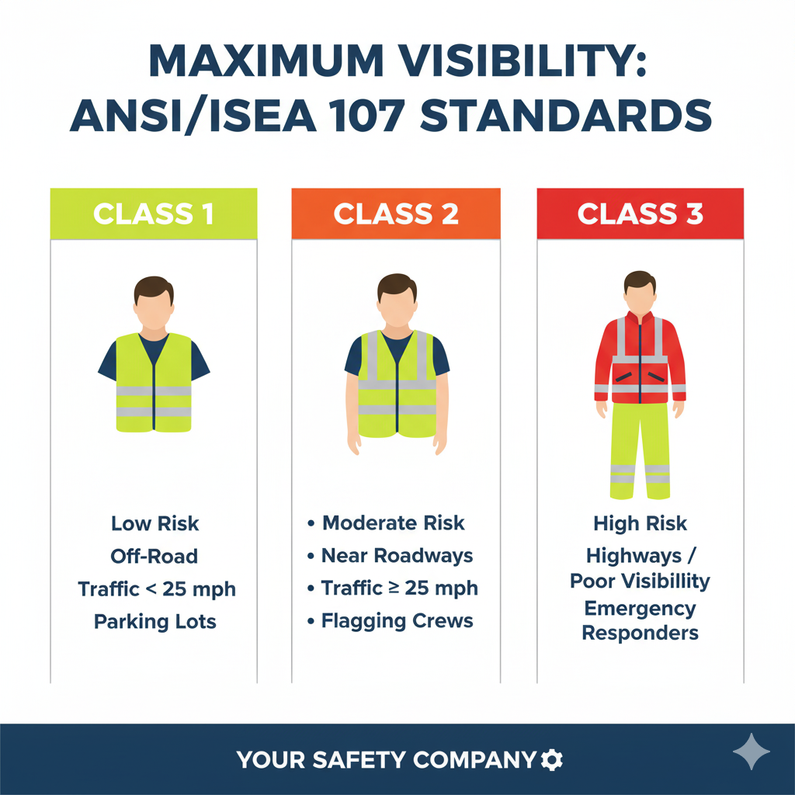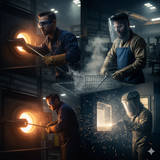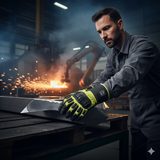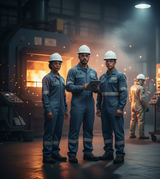Maximum Visibility: Breaking Down Hi-Vis Classes and the ANSI/ISEA 107 Standard
High-Visibility (Hi-Vis) apparel is perhaps the most fundamental form of Personal Protective Equipment (PPE) for anyone working near traffic, operating machinery, or in low-light conditions. These garments—the bright vests, shirts, and jackets—are crucial for minimizing "struck-by" incidents, which are a leading cause of fatalities in construction and utility work.
But not all hi-vis gear is created equal. The level of protection you need depends entirely on the work environment, proximity to moving vehicles, and the speed of traffic. This is where the ANSI/ISEA 107 standard comes in.
At Your Safety Company, we’re committed to ensuring your team is seen and safe. Here’s your guide to understanding the materials and the critical differences between Hi-Vis performance classes.
The Anatomy of High-Visibility Safety Apparel
ANSI/ISEA 107 dictates that effective hi-vis garments must utilize two essential types of material to ensure visibility under all conditions:
-
Fluorescent Background Material: This is the bright material (typically fluorescent yellow-green, orange-red, or red) that makes the garment highly conspicuous during the daylight hours and in low-light situations. It absorbs non-visible UV light and re-emits it as visible light, making the wearer stand out.
-
Retroreflective Material: This material (the silver or gray stripes) reflects light directly back to its source, illuminating the wearer when struck by light from vehicle headlights, flashlights, or street lamps in low-light or nighttime conditions.
Understanding the Performance Classes (Classes 1, 2, and 3)
The ANSI/ISEA 107 standard defines three performance classes (Class 1, Class 2, and Class 3) based on the minimum amount of visible material required. The higher the class, the greater the amount of fluorescent and retroreflective material, and the greater the distance from which the wearer can be seen.
? Class 1: Minimum Visibility
-
Requirement: Lowest amount of background and reflective material.
-
Intended Use: For workers in areas where traffic speeds are under 25 mph and the risk is minimal. The worker is usually separated from the traffic flow and is highly attentive to their surroundings.
-
Examples: Off-road tasks, general warehousing, or parking lot attendants.
? Class 2: Superior Visibility (The Standard for Roadways)
-
Requirement: Requires significantly more background and reflective material than Class 1. The reflective material must fully encircle the torso.
-
Intended Use: For workers exposed to traffic speeds of 25 mph or higher, or in poor weather conditions, complex backgrounds, or environments that require greater visual contrast. This is the minimum standard for most road construction, flagging operations, and utility workers near roadways.
-
Examples: Flaggers, utility crews, railway workers, and roadway construction personnel.
? Class 3: Maximum Visibility and Full Coverage
-
Requirement: Provides the greatest amount of fluorescent and retroreflective material. Critically, it requires full coverage of the arms and legs (meaning the garment must have sleeves, and often requires matching trousers or overalls).
-
Intended Use: For workers who are exposed to high-speed traffic (over 50 mph), or who are working in very low-visibility conditions, such as during emergencies, severe weather, or when the worker is not fully visible to approaching traffic. It offers the best possible conspicuity for maximum safety distance.
-
Examples: Emergency responders, incident management personnel, and all personnel working in high-risk zones or extreme weather.
Choosing the Right Class: The Safety Compliance Test
When selecting gear for your team, always default to the highest class required by your safety assessment.
Remember, using a Class 1 vest when a Class 3 garment is required can expose your workers and your company to serious risk and non-compliance fines.
At Your Safety Company, we supply a complete range of ANSI/ISEA 107 compliant vests, shirts, and jackets in Class 2 and Class 3, ensuring you meet the strictest requirements for visibility and safety.
Don't compromise on visibility. Visit yoursafetycompany.com today to equip your team with the right performance class gear for their environment!
? Important Disclaimer Note
The information provided in this guide is for educational and informational purposes only and is not a substitute for a professional risk assessment or compliance with federal, state, and local regulations (including OSHA standards). The ultimate responsibility for determining the appropriate ANSI/ISEA 107 performance class and ensuring site-specific safety compliance rests with the employer and the end-user. Consult all applicable safety standards and regulatory bodies for final PPE selection.
Recent Posts
-
More Than Goggles: The Specialized Eye Protection Needed for High-Heat Industrial Environments
In facilities that process metal at extreme temperatures, eye safety is a complex, multi-layered cha …12th Nov 2025 -
Double Defense: Why Cut and Impact Protection is Critical for Material Handling
In facilities that deal with heavy metal parts, sharp edges, and complex machining, a standard work …11th Nov 2025 -
Beyond the Flame: Why NFPA 2112 FR Apparel is Non-Negotiable
In high-risk industrial settings—from petrochemical plants and utilities to metal processing and hea …7th Nov 2025



